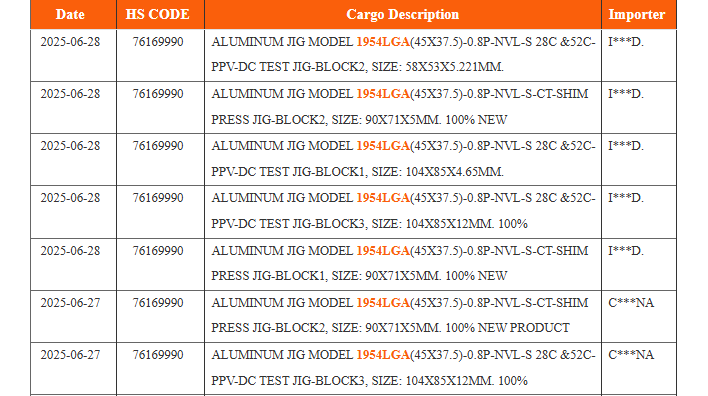Intel Nova Lake Desktop CPU Shipping Doc Highlights A New Socket & Up To 52 Cores
Indeed, customs data over at NBD Data shows a number of results for "ALUMINUM JIG MODEL 1954LGA", which is exactly the rumored socket for Nova Lake. These entries also specifically say "NVL-S 28C & 52C"—the two top core-count configurations for Nova Lake processors with one and two compute tiles, respectively. The compute tiles are said to include eight Coyote Cove P-cores and sixteen Arctic Wolf E-cores, combined with an additional four LP E-cores on the I/O die, which gives us 28 and 52 cores for single- and dual-tile configurations.
This gives credence to some of the other leaks about Nova Lake. We've heard that the processor may feature the long-awaited "bLLC" (Big Last Level Cache or Base [Tile] Last Level Cache) feature that could allow Intel to finally make up the ground in gaming performance versus AMD's "X3D" processors with 3D V-Cache. Chips so-equipped could have as much as 288 megabytes of L3 cache onboard, dwarfing even the Ryzen 9 9950X3D's 128 MB.
Graphics duties on Nova Lake are said to be handled by an Xe3-based GPU, sharing such architecture with the Panther Lake parts that are supposed to launch late this year. Nova Lake itself isn't expected to show up until next year, though, and likely in the latter half of the year at that. Before then, we're still expecting a refresh of the Arrow Lake series to bring along a minor clock bump, and so Nova Lake will likely end up being the Core Ultra 400 series.
Intel's CFO, David Zinsner, said last week that he expects Nova Lake will allow Intel to "improve its position" in the client desktop market. While we think some of the distaste from the DIY community toward Arrow Lake is overblown, it's definitely true that the Core Ultra 200S series isn't quite as compelling as AMD's Ryzen 9000 offerings. Hopefully both companies bring out baller hardware next year so we can enjoy renewed competition in the CPU space.


